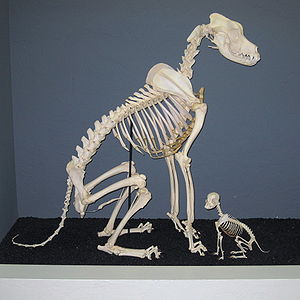How Long To Simmer Bones To Clean Them For Medical Display

Maceration is a bone preparation technique whereby a clean skeleton is obtained from a vertebrate carcass by leaving it to decompose inside a closed container at near-abiding temperature. This may be done as office of a forensic investigation, as a recovered trunk is too badly decomposed for a meaningful autopsy, but with enough flesh or peel remaining every bit to obscure macroscopically visible evidence, such equally cut-marks. In almost cases, maceration is done on the carcass of an animal for educational purposes.
Description [edit]
Maceration is a form of controlled putrefaction, a stage of decomposition in which the proteins of the body's cells are broken down and consumed past bacteria in anaerobic weather condition. The temperature is unremarkably maintained at a constant optimal temperature in an incubator. Maceration generates very strong and distasteful odors, and is therefore unremarkably done in a closed container in a ventilated area.
Maceration is an culling to the Dermestes method in which skin beetles are used to clean the flesh off of the corpse, a method which is used with corpses of small-scale mammals, birds, reptiles, and amphibians, considering these animals' bones tend to fall apart in many tiny parts. Maceration is an unsuitable method to clean the bones of a fish, as they have a poorly articulated, pliable skeleton.
Process [edit]

Skeleton of swine prepared by bone maceration
In the process of maceration, the carcass is first skinned and defleshed by mitt as much as is applied, and all internal organs are removed. In this process, extra intendance is taken when removing the eyeballs, ears and jugular muscles, because some bones are shallow and brittle, such equally the thickened external acoustic opening of many mammals. The tongue is usually left in place, because of its attachment to the hyoid os. Severed parts of the carcass are sometimes kept in nylon pantyhose. H2o is then put in a container and maintained a constant temperature, usually 35 °C though non warmer than 50 °C. Washing pulverization with enzymes (like Biotex) may exist added, as it will soften the tissue. A balmy detergent or emulsifier is sometimes used to remove fatty acids from the bone. When the carcass is put in the container, putrefying bacteria begin (or go along) to consume the soft tissue cells of the carcass, and will continue to do so as long as the temperature remains constant. Subsequently a few days, the water is replenished to maintain the bacteria, and some additional flesh may be cut away. Most medium-sized animals (like dogs) are diminished within about ten days.
Lipids and fat acids in the bone and in the fat tissues tend to stain the bone brown. Oxidising bleaches may exist used to whiten the bone, but if too much is used the perchlorate or hypochlorite damages the bone tissue, leaving it chalky and breakable. Hydrogen peroxide at quite low concentrations, say ane% to three% replenished every few days, is less inclined to harm the tissue, though information technology may take a week or two to achieve complete whiteness.
Completion [edit]
When the process of maceration is complete, the basic are removed from the solution and left to dry. If the skeleton is human and the field of study of an investigation, the forensic anthropologist will and so deport an inventory and analysis of the remains. If the individual is to be identified, occupational and age-related osteological markers will be noted, and measurements of the bones will provide evidence suggesting the individual's summit and race. If the skull is intact, forensic facial reconstruction is some other selection that may aid in identifying the individual. If a criminal offence has been established, an exam of the bones without overlying soft tissue may provide show on what weapon (if any) was used or on the nature of the injuries sustained.
In well-nigh cases, an brute is macerated for educational purposes. Once dry, the bones are collected, inventoried, and sometimes labelled or separated into labelled bags, all of which may then exist placed in a container for storage. Alternately, steel wire is used to accommodate the bones to appear as an articulated skeleton, and posed as the animal might accept stood in life.
See also [edit]
- Bioarchaeology
- Forensic anthropology
- Osteology
- Zoology
Source: https://en.wikipedia.org/wiki/Maceration_(bone)
Posted by: ellisbelve1990.blogspot.com


0 Response to "How Long To Simmer Bones To Clean Them For Medical Display"
Post a Comment